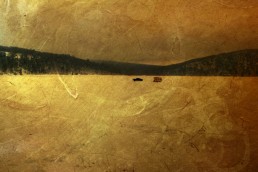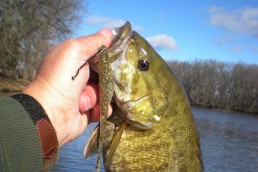Why Great Anglers Catch More Fish Than You Do
SHARE THIS POST
Over the years I’ve fished with some fine anglers: Pike in Saskatchewan with Pete Maina, resulting in The Next Bite, a show featuring fly fishing for the species; steelhead in Michigan with Squeak Smith, identified as one of “10 Who Made a Difference” in the 50-year history of Trout Unlimited; and for bass with folks on the B.A.S.S. and FLW tours. These are ones who catch fish when the rest of us are complaining about cold fronts, water skiers and the myriad of other excuses.
As I ponder what I’ve learned from this cadre of elite anglers, a number of factors emerge. One: they cast better. Jim Nolan worked for Ranger Boats and was a regular on the professional bass tours. When I fished with him he maneuvered the boat and told me to skip my 1/2-ounce jig-and-pig under dangling willow branches. I told Jim I couldn’t skip a heavy jig, but I knew he could do it.
The next factor is they are on the water more. They aren’t dependent on where fish were necessarily a year ago, or, if someone else recommends hot lure.
But the most important reason elite anglers catch more is they concentrate better. After a long day on the water—perhaps without a strike for hours—they still catch the only “fish of the day.”
There are several elements for this they employ, in terms of angling concentration.
1. Keep in touch with your lure.
Feel the wiggle of your crankbait or the thump of the blades on your spinnerbait. When the wiggle or thump varies, that may be a lunker. Be able to distinguish when your jig-and-pig bumps a brush pile or when it feels “mushy” and a fish has it.
A chap who fished the B. A. S. S. trail told me once about using a Texas-rig worm or lizard:
“The first bump you feel is when the bass grabs it; the second bump is when he lets go.”
Know where in the water your lure is. Read the amount of line reeled in and the angle where the line enters the water. Your knowledge on how deep the lure runs if important. If the lure hits something it will tell you where the brush pile is, where the ledge is and where the sand turns to rock. A sudden flash or movement of weeds may also signal a strike you didn’t feel.
2. Watch your line.
Are you enjoying this post?
You can be among the first to get the latest info on where to go, what to use and how to use it!
Watching this is particularly important while using “fall” baits, as lures are best fished when allowed to sink slowly to the bottom. Walleye and smallmouth fans know small jigs and plastic trailers are good examples. Line watching is most effective if the lure drops with a little slack in the line. A quick twitch in the slack is a sure sign something grabbed the falling lure. Craig, my son, actually caught his first 5-pound largemouth when he noticed his line was not where he thought it should be.
3. Keep your lure in the water.
The best anglers don’t waste time examining the content of their tackle boxes or chatting on their smartphones. The retrieve of one cast becomes the beginning of the next. When I fished with Pete Maina on Phelps Lake—though he and I had had a running conversation about how inadequate the other was—he never dallied in getting his lure back in the water. Over the course of a day, an angler who makes 1 1/2 casts to another making one cast will have a lure in the water a third more.
4. Have a purpose for each cast.
If fishing a drop-off, make sure to cast far enough so the lure will be in the zone where fish hold: the lip of the area. A sinking lure will swing back toward the boat as it falls. And remember, crankbaits cannot dive at an angle greater than 45 degrees. In either case, a cast that seems to have the right distance may pass several feet over fish.
5. Pay attention to your surroundings.
Nature provides lots of clues. A blue heron wading along a bank is a good sign small fish are present, and these are likely prey for the bass or muskies. Diving gulls also feed on small fish driven to the surface by gamefish foraging below. Shadows of trees, piers and boathouses, or other structures, provide cover in otherwise barren spots. And piers with rod holders indicate where brush piles are located.
6. Read the bank.
Lots of us fish reservoirs. The outside curve of a river is usually the deepest side. Steep banks often drop off quickly to deep water. Rocky banks hold crayfish. Points extend beyond the shore and the angle of the slope above water is a good indication of a slope under water. A log fallen in the water is probably much like those remaining on the bank suggesting how far limbs extend, providing cover for fish.
7. Expect a fish on every cast.
Be ready all the time. Years ago I was a press observer at a Bass’N Gal Classic on Lake Kentucky. Linda England came in second, trailing the winner by only 1 ounce. She said after a long, slow day that she was eagerly thinking about heading to the landing when all of a sudden a 2-pound largemouth hit her spinnerbait—she missed it.
There are many reasons the “best” practitioners of any art are better than the rest of us. Among anglers, powers of concentration are prime factors in making the best, better.
MWO
SHARE THIS POST
Did you enjoy this post?
You can be among the first to get the latest info on where to go, what to use and how to use it!
Tim Mead
Tim Mead is an established outdoor writer and photographer with more than 500 credits in state, regional and national magazines. He is an “Excellence in Craft” award winner from both the Outdoor Writers Association of America (of which he is also vice president) and the Southeast Outdoor Press Association (as well as being past president).



